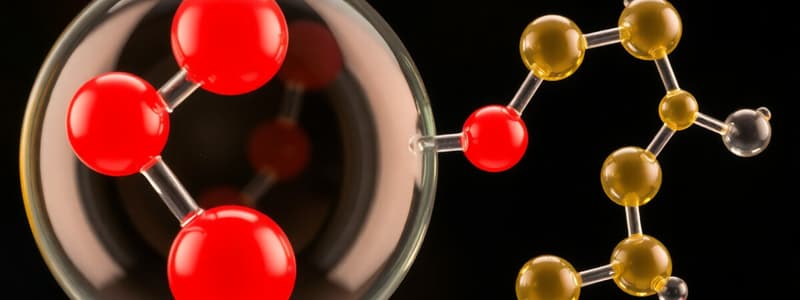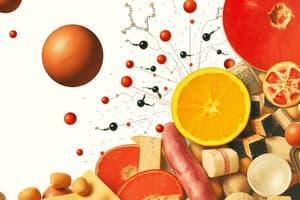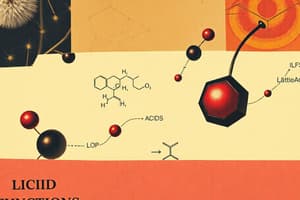Podcast
Questions and Answers
Which lipoprotein is responsible for transporting dietary lipids from the intestines to the liver?
Which lipoprotein is responsible for transporting dietary lipids from the intestines to the liver?
- Very Low-Density Lipoproteins (VLDL)
- Chylomicrons (correct)
- Intermediate-Density Lipoproteins (IDL)
- High-Density Lipoproteins (HDL)
What is the primary component of triglycerides?
What is the primary component of triglycerides?
- Cholesterol and 3 fatty acids
- Glycerol and 4 fatty acids
- Glycerol and 3 fatty acids (correct)
- 2 glycerols and 3 fatty acids
Which apoprotein is primarily associated with an increased risk of coronary heart disease (CHD)?
Which apoprotein is primarily associated with an increased risk of coronary heart disease (CHD)?
- Apolipoprotein C
- Apolipoprotein B (Apo-B) (correct)
- Apolipoprotein E (Apo-E)
- Apolipoprotein A (Apo-A)
Which condition is characterized by extremely low HDL levels and enlarged orange-colored tonsils?
Which condition is characterized by extremely low HDL levels and enlarged orange-colored tonsils?
What is a common consequence of having increased LDL levels?
What is a common consequence of having increased LDL levels?
What is the role of Apolipoprotein A (Apo-A) in lipid metabolism?
What is the role of Apolipoprotein A (Apo-A) in lipid metabolism?
Which type of lipoprotein is known as 'Good' cholesterol?
Which type of lipoprotein is known as 'Good' cholesterol?
What process occurs in the small intestine during fat absorption after triglycerides are emulsified by bile salts?
What process occurs in the small intestine during fat absorption after triglycerides are emulsified by bile salts?
Which lipoprotein is associated with the transport of endogenous triglycerides from the liver to peripheral tissues?
Which lipoprotein is associated with the transport of endogenous triglycerides from the liver to peripheral tissues?
What is the recommended LDL cholesterol level in mg/dL for optimal health?
What is the recommended LDL cholesterol level in mg/dL for optimal health?
What role do VLDL lipoproteins serve in lipid metabolism?
What role do VLDL lipoproteins serve in lipid metabolism?
What is the main structural difference between triglycerides and phospholipids?
What is the main structural difference between triglycerides and phospholipids?
What is one of the consequences of Familial Hypercholesterolemia?
What is one of the consequences of Familial Hypercholesterolemia?
How do lipoproteins(a) contribute to cardiovascular risk?
How do lipoproteins(a) contribute to cardiovascular risk?
What is one primary function of apoproteins in lipid metabolism?
What is one primary function of apoproteins in lipid metabolism?
Which statement about cholesterol synthesis is correct?
Which statement about cholesterol synthesis is correct?
What characterizes hypertriglyceridemia?
What characterizes hypertriglyceridemia?
What condition is associated with a defect in apolipoprotein E (Apo-E)?
What condition is associated with a defect in apolipoprotein E (Apo-E)?
In which phase of lipids absorption do micelles play a crucial role?
In which phase of lipids absorption do micelles play a crucial role?
What is the primary reason for the 'Good' HDL cholesterol's beneficial effects on cardiovascular health?
What is the primary reason for the 'Good' HDL cholesterol's beneficial effects on cardiovascular health?
Which of the following statements accurately describes the composition of lipoproteins?
Which of the following statements accurately describes the composition of lipoproteins?
What is the main function of chylomicrons in lipid metabolism?
What is the main function of chylomicrons in lipid metabolism?
Which condition is most associated with increased triglyceride levels and cardiovascular risk?
Which condition is most associated with increased triglyceride levels and cardiovascular risk?
What role does the liver play in cholesterol levels in the body?
What role does the liver play in cholesterol levels in the body?
What is the effect of statins in managing lipid levels?
What is the effect of statins in managing lipid levels?
Which of the following lipoproteins is considered 'Bad' cholesterol?
Which of the following lipoproteins is considered 'Bad' cholesterol?
What factor is crucial in assessing cardiovascular risk based on lipoproteins?
What factor is crucial in assessing cardiovascular risk based on lipoproteins?
What defines the disease condition known as Hyperlipoproteinemia?
What defines the disease condition known as Hyperlipoproteinemia?
What is the mechanism by which Apo-B contributes to cardiovascular disease risk?
What is the mechanism by which Apo-B contributes to cardiovascular disease risk?
Flashcards
Triglycerides
Triglycerides
Lipids composed of three fatty acids and glycerol; major component of dietary fat (98-99%).
Fatty Acid Types
Fatty Acid Types
Saturated (solid at room temp) and unsaturated (liquid at room temp) fatty acids.
Phospholipids
Phospholipids
Lipids with two fatty acids and glycerol, key components of cell membranes and lipid transport.
Cholesterol
Cholesterol
Signup and view all the flashcards
Lipoproteins
Lipoproteins
Signup and view all the flashcards
HDL (High-Density Lipoprotein)
HDL (High-Density Lipoprotein)
Signup and view all the flashcards
LDL (Low-Density Lipoprotein)
LDL (Low-Density Lipoprotein)
Signup and view all the flashcards
Chylomicrons
Chylomicrons
Signup and view all the flashcards
LDL Cholesterol Level Goal
LDL Cholesterol Level Goal
Signup and view all the flashcards
Lipid Metabolism
Lipid Metabolism
Signup and view all the flashcards
Why are lipids important?
Why are lipids important?
Signup and view all the flashcards
What are essential lipids?
What are essential lipids?
Signup and view all the flashcards
What are triglycerides?
What are triglycerides?
Signup and view all the flashcards
What's the difference between saturated and unsaturated fats?
What's the difference between saturated and unsaturated fats?
Signup and view all the flashcards
What are phospholipids?
What are phospholipids?
Signup and view all the flashcards
What is cholesterol?
What is cholesterol?
Signup and view all the flashcards
How is cholesterol transported?
How is cholesterol transported?
Signup and view all the flashcards
What is HDL cholesterol?
What is HDL cholesterol?
Signup and view all the flashcards
What is LDL cholesterol?
What is LDL cholesterol?
Signup and view all the flashcards
What is the role of apolipoproteins?
What is the role of apolipoproteins?
Signup and view all the flashcards
What makes lipids unique?
What makes lipids unique?
Signup and view all the flashcards
What's a triglyceride?
What's a triglyceride?
Signup and view all the flashcards
Saturated vs. Unsaturated Fats
Saturated vs. Unsaturated Fats
Signup and view all the flashcards
What's cholesterol's role?
What's cholesterol's role?
Signup and view all the flashcards
What are lipoproteins?
What are lipoproteins?
Signup and view all the flashcards
What's 'good' cholesterol?
What's 'good' cholesterol?
Signup and view all the flashcards
What's 'bad' cholesterol?
What's 'bad' cholesterol?
Signup and view all the flashcards
How are fats absorbed?
How are fats absorbed?
Signup and view all the flashcards
Study Notes
Lipid Overview
- Lipids are largely insoluble in water, but some have polar groups enabling partial solubility.
- Essential lipids, like triglycerides and certain fatty acids, must be obtained through diet.
Types of Lipids
- Triglycerides:
- Composed of three fatty acids and glycerol; comprise the majority of dietary lipids (98-99%).
- Animal sources are saturated fats (solid at room temperature).
- Plant sources are unsaturated fats (liquid at room temperature).
- Metabolized by lipase enzymes, transported to tissues via VLDL.
- Phospholipids:
- Composed of two fatty acids and glycerol.
- Found on lipid surfaces, crucial for cell membranes and lipid transport.
- Amphipathic molecules (both hydrophobic and hydrophilic regions).
- Cholesterol:
- A sterol, either free or esterified with fatty acids, located on lipid surfaces.
- Synthesized primarily in the liver (about 70%).
- Plant-derived phytosterols are similar to cholesterol.
- Transported by HDL to remove excess from tissues.
Lipoproteins
- Lipoproteins are lipid-protein complexes transporting lipids in the bloodstream.
- Chylomicrons:
- Transport dietary lipids from intestines to liver and peripheral tissues.
- Cause milky plasma after a high-fat meal.
- HDL (High-Density Lipoprotein):
- "Good" cholesterol, removes excess cholesterol from cells, returning it to the liver for excretion.
- LDL (Low-Density Lipoprotein):
- "Bad" cholesterol, delivers cholesterol to cells; high levels contribute to arterial plaque.
- VLDL (Very Low-Density Lipoprotein):
- Transports endogenous triglycerides from the liver to peripheral tissues.
- IDL (Intermediate-Density Lipoprotein):
- Forms during lipid metabolism, transitions between VLDL and LDL.
- Lipoprotein(a):
- Similar to LDL but with apolipoprotein(a), inhibiting fibrinolysis (clot breakdown), increasing cardiovascular risk.
Apoproteins
- Apoproteins are the protein components of lipoproteins, maintaining structure and regulating lipid metabolism.
- Apo-A: Predominantly in HDL; associated with lower coronary heart disease risk.
- Apo-B: Primarily in LDL; associated with increased coronary heart disease risk.
- Assessing the Apo-A/Apo-B ratio helps evaluate cardiovascular risk.
Fat Absorption
- Digestive Phase: Bile salts emulsify triglycerides in the small intestine; pancreatic lipase breaks them into fatty acids and monoglycerides.
- Absorptive Phase: Free fatty acids and monoglycerides form micelles, absorbed by intestinal cells; re-esterified into triglycerides, packaged with cholesterol and apoproteins into chylomicrons.
- Transport Phase: Chylomicrons deliver lipids to adipose tissue, muscle, and liver.
Lipid Normal Levels
- LDL Cholesterol: Less than 100 mg/dL (statins lower LDL).
- HDL Cholesterol: Greater than 40 mg/dL (men), 50 mg/dL (women). (Niacin raises HDL).
- Total Cholesterol: Less than 200 mg/dL.
Lipid Disorders
- Hypercholesterolemia (Increased LDL): Arterial plaque buildup, increasing heart disease risk.
- Familial Hypercholesterolemia: Genetic defect in LDL receptors, very high LDL.
- Hypoalphalipoproteinemia (Decreased HDL):
- Tangier Disease: Extremely low HDL, enlarged, orange-colored tonsils.
- Hypertriglyceridemia (Increased Triglycerides):
- Hyperlipidemia: Elevated triglycerides and cholesterol, increasing pancreatitis and cardiovascular risk.
- Lipoprotein Lipase Deficiency: Absent or deficient lipoprotein lipase, extremely high triglycerides, risk of pancreatitis.
- Hyperlipoproteinemia (Increased Lipoproteins):
- Type V Hyperlipoproteinemia: Elevated chylomicrons and VLDL, eruptive xanthomas, lipemia retinalis.
- Dysbetalipoproteinemia (Type III): Defect in apolipoprotein E (Apo-E), LDL accumulation, palmar xanthomas, premature atherosclerosis.
Studying That Suits You
Use AI to generate personalized quizzes and flashcards to suit your learning preferences.




